With S3 Browser you may automatically compress and/or encrypt files before uploading them to Amazon S3 and
automatically decompress and/or decrypt them after downloading.
The ZIP format is used for data
compression and AES 256 symmetric algorithm for data encryption, allowing you to decompress/decrypt files
with any 3-rd party archive manager.
The GZip format is also supported for
cases when you need to serve compressed files over the Internet.
You may also decompress and/or decrypt files automatically when downloading them using
S3 Browser. If password is not found on the local computer, you will be asked to
enter it before downloading the file(s).
Compression and encryption can be easily configured using flexibe set of rules.
You may configure rules on bucket, folder or file level.
The rules are stored locally in S3 Browser settings folder. If you define the rules on a Machine A and then upload
the file from the Machine B, the rules are not applied. You may transfer rules to another computer, they are located
in the %APPDATA%\S3Browser folder in the file named bucket.rules.
Below you will find detailed description of compression and encryption rules.
To open Compression and Encryption rules manager:
Click Tools -> Compression and Encryption
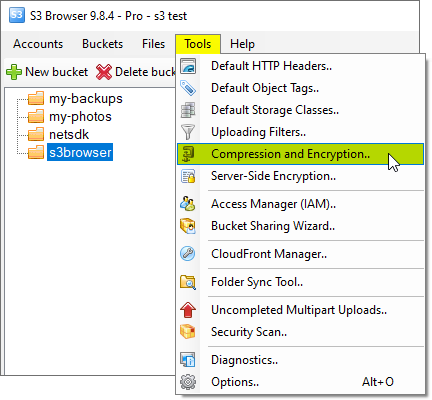
Click Tools -> Compression and Encryption
The Compression and Encryption Rules dialog will open:
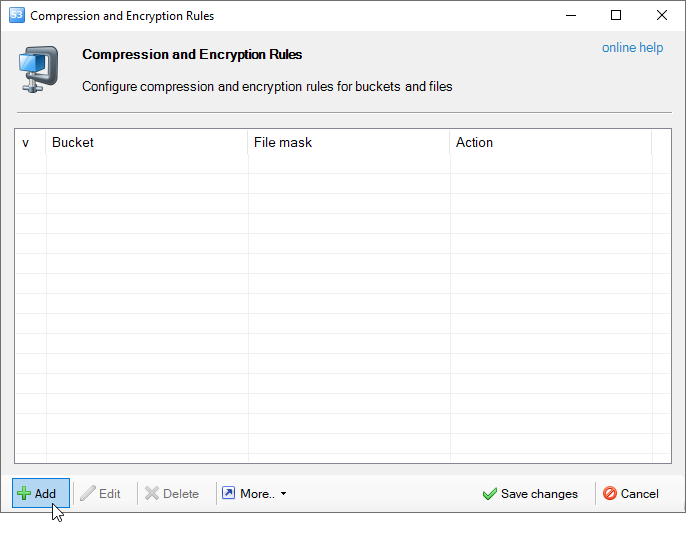
The Compression and Encryption Rules dialog
To add new Compression/Encryption rule
1. Click the Add button (or press the Ins keyboard shortcut).
The Add New Compression/Encryption Rule dialog will open:
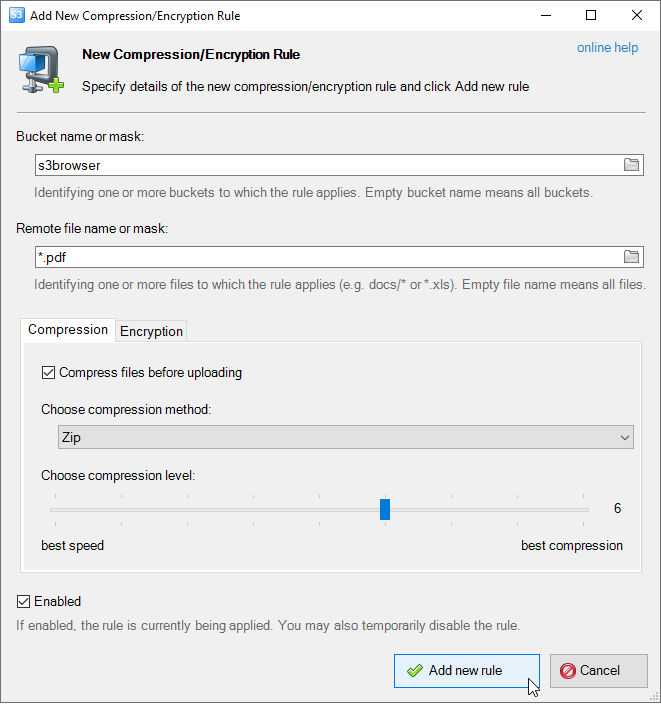
Add new Compression/Encryption rule dialog
2. Fill out the following optional fields:
Bucket name or mask: - Identifying one or more buckets to which the rule applies.
Empty bucket name means all buckets.
Remote file name or mask: - Identifying one or more files to which the rule applies
(e.g. docs/* or *.xls). Empty file name means all files.
Check Compress files before uploading checkbox to compress files before uploading them to Amazon S3.
Choose the Compression method: Zip (for regular uploads) or GZip (for files distributed over the Internet)
You may also adjust Compression level. Better compression takes more time and CPU/RAM,
lower compression is faster and requires less resources.
Avoid enabling compression for already compressed files such as jpg, gif, png images,
compressed video files, archives (zip, rar, 7z, etc.).
Be also careful when enabling compression for very large files, this may take a lot of time and CPU resources.
Check Encrypt files before uploading checkbox and specify Encryption password
if you would like to encrypt files before uploading them to Amazon S3.
Compression/Encryption rules are stored in plain form,
so you may want to delete them when upload is finished.
You may also temporarily enable/disable the rule using corresponding check-box.
3. Click Add new rule to close the dialog.
4. Click Save changes to save changes and close rules manager.
To edit Compression/Encryption rule
1. Select the rule you want to edit and click the Edit button
The Edit Compression/Encryption rule dialog will open:
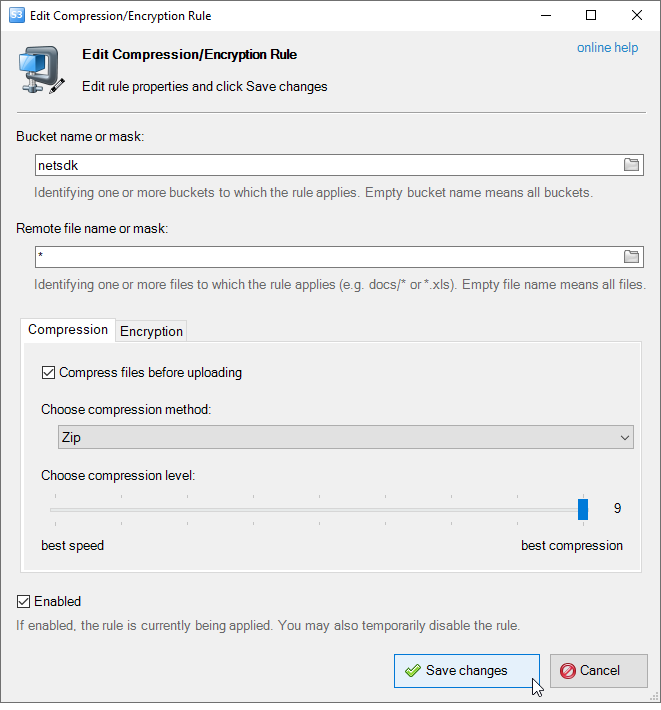
How to edit Compression/Encryption rule
2. Edit rule details and click Save Changes
3. Click Save changes to close rules manager and save changes
To delete Compression/Encryption rule(s)
1. Select one or more rules you want to delete and click Delete
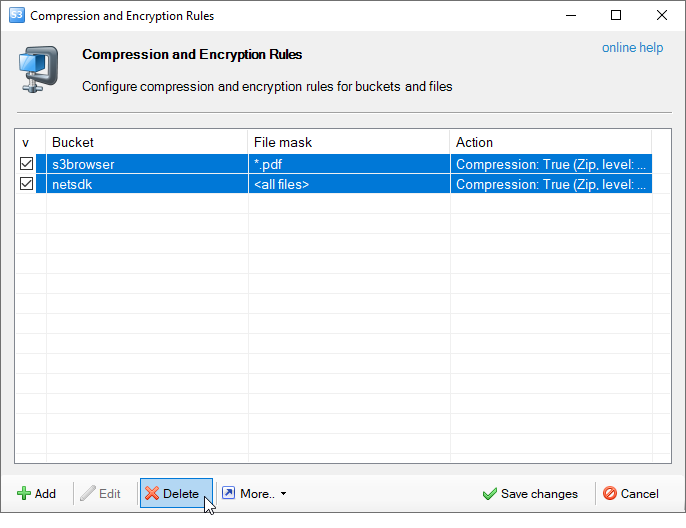
How to delete Compression/Encryption rule(s)
2. Click Save changes to close rules manager and save changes
Downloading compressed/encrypted file(s)
If you download compressed file with S3 Browser,
the file decompressed automatically when download is finished.
If file is encrypted, S3 Browser looks into compression/encryption rules and if corresponding
encryption rule is found, the password is taken from the rule to decrypt the file.
If no matching rule is found, you will be asked to enter decryption password:

You can specify decryption password when downloading encrypted files
The following options are available:
Enter decryption password - you may enter decryption password for the file
Download encrypted file 'as is' - decryption is not performed, the file is downloaded in encrypted form.
Do not download this file - the file will be skipped
You may also tick the Remember my choice for other files in the queue checkbox to apply your choice
for other files in the queue.
If the password you specified is not valid, you will see the following dialog:
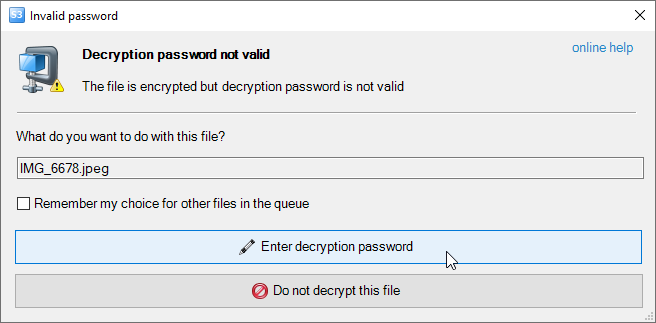
You can re-enter decryption password when downloading encrypted files
The following options are available:
Enter decryption password - you may re-enter decryption password for the file
Do not decrypted this file - decryption is skipped, the file is downloaded in encrypted form.
Decompressing/Decrypting files without S3 Browser
If you download compressed/encrypted files via other tools, or via old version of S3 Browser,
you may still decompress/decrypt them with any 3-rd party archive manager.
You may use free open-source archiver 7-zip:
1. Start 7-zip archive manager, select the file(s) and click Extract
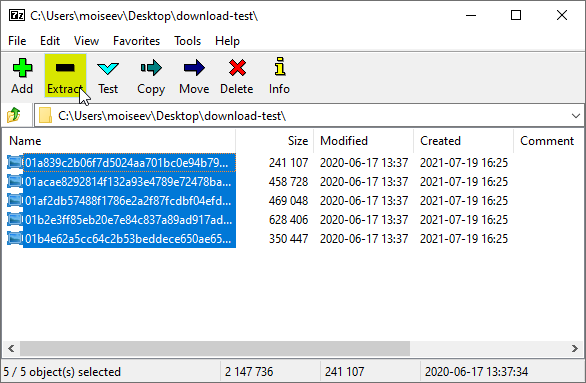
How to decompress/decrypt files using 7-zip
2. Specify decryption password if files are encrypted and click OK
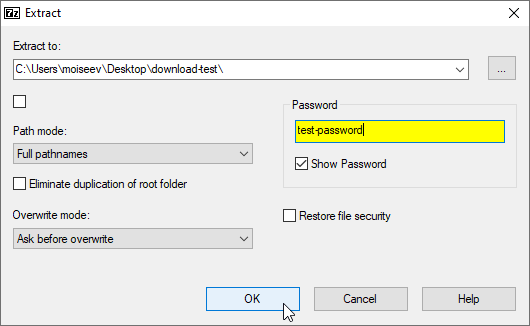
You may also specify password in 7-zip archive manager

